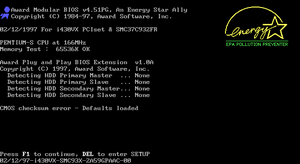AwardBIOS, also known as Award Modular BIOS, is a personal computer BIOS developed by Award Software from 1984 to 1998 and by Phoenix Technologies from 1998 until its discontinuation on June 30, 2009.[1] Despite this, it was still being used on some newer motherboards based on older chipsets in the 2010s. In addition, Gigabyte continued independently developing their AwardBIOS v6.00PG fork after this date. This fork was used for up to 6-series chipsets (H6x/Q6x/B65/P67/Z68) for Intel platforms and up to 9xx series chipsets (specifically 990FX) for AMD platforms. The last known motherboard with this fork is the GA-78LMT-USB2 R2, based on the AMD 760G chipset and released in 2017.
Award Software

Award Software International Inc. was a software development company founded in 1983 by Rene Vishney and Bob Stillman. It was founded in San Jose, California and later relocated to Los Gatos next year. In 1988, Stillman left the company, while Vishney continued being the chairman and his wife Deborah Lee became the CEO.
Acquisition by GCH Systems
In 1993, the company was acquired by the Taiwanese firm GCH Systems Inc., which was originally founded by George C. Huang in 1984 in Sunnyvale, California. GCH Systems was officially dissolved on December 16, 2023, 30 years after the Award acquisition.[2]
Unicore Software acquisition
On June 16, 1997, the company announced the acquisition of Unicore Software Inc., a BIOS upgrade provider based in North Andover, Massachusetts.[3] This occurred a few years after Unicore acquired Microid Research Inc. (MRI). Therefore, with this acquisition, Award also gained the ownership of MR BIOS.
Phoenix merge and dissolution
On April 16, 1998, Award announced a merger agreement with Phoenix Technologies to create a $100 million BIOS development firm.[4] Under the agreement, Phoenix would be the surviving corporate identity, while Award would dissolve. The agreement was completed on September 28th of that year and the company officially dissolved on February 9, 2001.[5] Meanwhile, GCH Systems owner George Huang became the board member and vice chairman of Phoenix until March 2006.[6]
List of known versions
| Version | Release date | POST screen | Notes |
|---|---|---|---|
| AwardBIOS 1.xx | 1984 | Not available | Confirmed to exist based on strings from a diagnostics program . Not much else is known. |
| AwardBIOS 2.xx | 1985 | 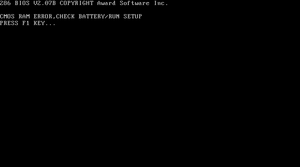
|
Likely the first version with a built-in setup utility, as seen on some of its later instances. |
| AwardBIOS 3.xx | 1987 | 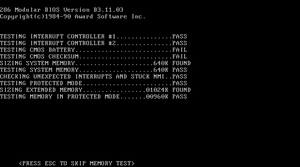
|
Siemens-Nixdorf also developed a fork based on this version. |
| AwardBIOS v4.00 | 1990 | 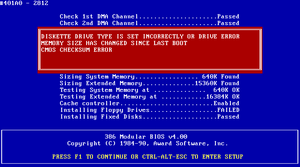
|
First version with the blue POST screen |
| AwardBIOS v4.2x/4.3x | Circa 1991-1992 | 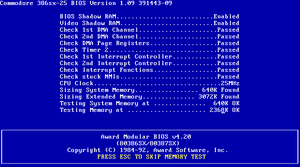
|
Usually seen with the version number v4.20. Other version numbers (such as v4.26, v4.28 and v4.32) can also be seen on some Gateway 2000 computers, although this may also be a modification by Anigma, which made their motherboards. |
| Award EliteBIOS (v4.5x/4.6x) | 1993 | 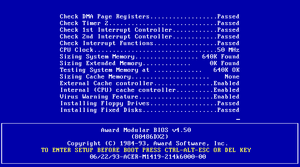
|
Earlier instances of AwardBIOS v4.50 use the blue POST screen. Meanwhile, later instances, along with all later versions, use the black POST screen. |
| Award PowerBIOS | 1994(?) | 
|
Internally named AwardBIOS v5.00. Usually seen on embedded computers and is uncommon. |
| AwardBIOS v6.00PG | 1998 | 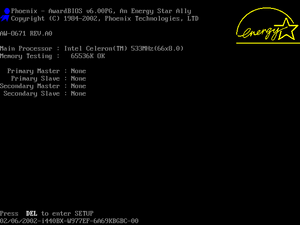
|
Codenamed "Medallion" and released shortly before the Phoenix merge. A sub-version called WorkstationBIOS v6.00PG was also released in around 2001.
ASUS and Gigabyte also developed forks based on this version. |
PhoenixNet controversy
Main page: PhoenixNet
In 2000, Phoenix released an add-on for Award EliteBIOS (specifically versions v4.51xx and v4.60xx) and Medallion (v6.00PG) called PhoenixNet. When enabled, it provided various features on a computer with Windows 98 or Millennium Edition installed, including:
- Automatic installation of sponsored software and other applications chosen by the manufacturer on a new installation of Windows 98/ME
- Automatic addition of sponsored hotlinks to the desktop and the installed web browser.
- Changing the default web browser home page and search settings to the ones set by the system manufacturer for consistency with the system language and locale
The add-on was heavily criticized by various PC enthusiasts online since the pre-installed software could be seen as bloatware and due to privacy concerns, the latter especially because it was noticed that PhoenixNet connected to the Phoenix home page on every startup when enabled.
Phoenix discontinued the add-on sometime in 2001, citing "the demise of the Internet advertising market" as the reason.[7]
- ↑ https://web.archive.org/web/20100102014331/http://phoenix.com/NR/rdonlyres/41C4EE68-A650-4969-805D-08F8798DF108/0/EOMletter_Award.pdf
- ↑ https://bizfileonline.sos.ca.gov/api/report/GetImageByNum/216187144179103006213063034162143116038214189110
- ↑ https://web.archive.org/web/19971122054540/http://www.award.com/Press/97_6_16.htm
- ↑ https://web.archive.org/web/19981202192141/http://www.award.com/press/98_4_15m.htm
- ↑ https://bizfileonline.sos.ca.gov/api/report/GetImageByNum/012154091108164216177218230180091169153208140005
- ↑ https://www.aaapoe.net/ntu/DrGeorgeHuang/DrGeorgeHuang.pdf (Page 4)
- ↑ https://www.cexx.org/phoenix.htm
